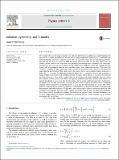Inflation, symmetry, and B-modes
Author(s)
Hertzberg, Mark Peter
DownloadHertzberg-2015-Inflation, symmetry.pdf (340.7Kb)
PUBLISHER_CC
Publisher with Creative Commons License
Creative Commons Attribution
Terms of use
Metadata
Show full item recordAbstract
We examine the role of using symmetry and effective field theory in inflationary model building. We describe the standard formulation of starting with an approximate shift symmetry for a scalar field, and then introducing corrections systematically in order to maintain control over the inflationary potential. We find that this leads to models in good agreement with recent data. On the other hand, there are attempts in the literature to deviate from this paradigm by envoking other symmetries and corrections. In particular: in a suite of recent papers, several authors have made the claim that standard Einstein gravity with a cosmological constant and a massless scalar carries conformal symmetry. They claim this conformal symmetry is hidden when the action is written in the Einstein frame, and so has not been fully appreciated in the literature. They further claim that such a theory carries another hidden symmetry; a global SO(1,1) symmetry. By deforming around the global SO(1,1) symmetry, they are able to produce a range of inflationary models with asymptotically flat potentials, whose flatness is claimed to be protected by these symmetries. These models tend to give rise to B-modes with small amplitude. Here we explain that standard Einstein gravity does not in fact possess conformal symmetry. Instead these authors are merely introducing a redundancy into the description, not an actual conformal symmetry. Furthermore, we explain that the only real (global) symmetry in these models is not at all hidden, but is completely manifest when expressed in the Einstein frame; it is in fact the shift symmetry of a scalar field. When analyzed systematically as an effective field theory, deformations do not generally produce asymptotically flat potentials and small B-modes as suggested in these recent papers. Instead, deforming around the shift symmetry systematically, tends to produce models of inflation with B-modes of appreciable amplitude. Such simple models typically also produce the observed red spectral index, Gaussian fluctuations, etc. In short: simple models of inflation, organized by expanding around a shift symmetry, are in excellent agreement with recent data.
Date issued
2015-04Department
Massachusetts Institute of Technology. Center for Theoretical Physics; Massachusetts Institute of Technology. Department of PhysicsJournal
Physics Letters B
Publisher
Elsevier
Citation
Hertzberg, Mark P. “Inflation, Symmetry, and B-Modes.” Physics Letters B 745 (May 2015): 118–124.
Version: Final published version
ISSN
03702693